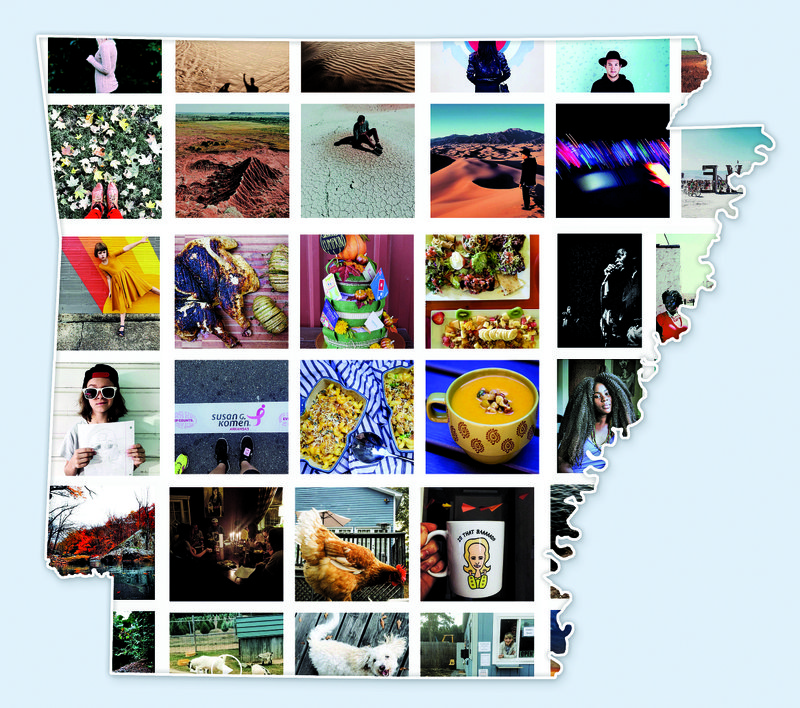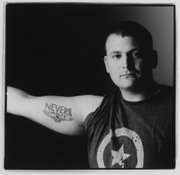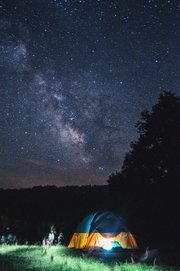Brenton Little, 32, of Rogers, or @brenton_clarke (as more than 251,000 people know him), was an early adopter of Instagram, creating an account in October 2010, the month the mobile app was released.
Five years later, he has traveled all over the United States, shooting Instagram-fueled photography for various brands. Represented by Tinker Street, an agency-cum-collective that negotiates corporate partnerships for its members, he was hired by the Bentonville marketing firm Ivie & Associates Inc. to handle Wal-Mart, among other accounts, partly because of his impressive Instagram presence.
Tim Landis (@curious2119), a Siloam Springs-based user with more than 655,000 followers, has worked with Nike, the U.S. Army, Mercedes, Samsung and Ford, while other Arkansas Instagramers (or "igers," in tech lingo) have been sent complimentary products to feature on their feed -- everything from socks to children's books.
What is now the world's most popular photo-sharing app was initially available only to iPhone users, who had to shoot and edit within the app. In April 2012, Instagram debuted an Android version, and that same month, Facebook bought the app for $1 billion.
All of the 100 most popular Instagram accounts have more than 6.8 million followers, with the most popular, Instagram itself, charting 107 million followers. These days many igers use nonmobile (often professional-grade) cameras and outside editing apps. Instagram has 400 million users -- more than Twitter or Tumblr -- even after accounting for 8 million bot users, metrics suggest.
COMMERCIALIZING COMMUNITY
Instagram debuted "sponsored posts" in November 2013. But corporations had been paying popular private users, such as Little and Landis, for product placement for years. Because of Instagram, Little shot for Land Rover in The Smoky Mountains, for Ford in Los Angeles and the Ozarks, for Mercedes in the Mojave Desert and for Samsung in the Wichita Mountains of Oklahoma.
Photographer Jeff Rose, 29, from Cave City, created an Instagram account about three years ago to attract clients (@thejeffrose; more than 82,200 follow-ers). He has Instagrammed watches displayed against a waterfall for the Swiss company Daniel Wellington and merchandise for Fayettechill Clothing Co. and Rock Monkey Outfitters, and posted pics of his friends around a campfire in Urban Outfitter apparel or using tents provided by REI and Kelty. Largely because of Instagram, Rose is able to freelance full time.
In interviews, Instagram co-founders Kevin Systrom and Mike Krieger have said that they envisioned the app as a quick, visual way for people to share their lives. The app includes effects -- filters and frames -- that could instantly weather, sun-flare or hyper-saturate an ordinary snapshot.
"When I started, I was the worst," says Hannah Carpenter, 33, an illustrator from a small town in central Arkansas. "I was posting seven times a day."
Little's first posts were snapshots of his infant son, his wife and himself at an ugly sweater Christmas party, minutiae of daily life -- a bottle of ginger beer, children's toys, sketches on notepads, a Starbucks cup -- spiffed up with nonuniform effects. Now his feed displays careful takes on mist, mountains, desert and sunsets, with his wife and children making only occasional, excellently rendered appearances.
"It wasn't until one of my Instagram buddies mentioned the concept of a gallery that I ever really thought about that," says Carpenter (@HannahaCarpenter; more than 46,100 followers). "I started being more intentional. ... I like something that looks clean and kind of normal, kind of filterless."
But while many high-profile igers have switched to professional cameras, Little and Carpenter still shoot primarily with iPhones.
And despite the photography jobs that have come to Little via Instagram (about three or four big gigs a year, he says), he doesn't consider himself a photographer: "I never took photography classes. ... I think I'm a designer. I don't see things as a photo. I see things as composition."
Rose's feed was never "instant." From the beginning, he posted photos shot on his Nikon D7000. But he credits Instagram with helping him develop the "lifestyle motif" that has led to many of his photography contracts.
"Before, it was all nature and wildlife type stuff. ... The people aspect of my photography really started once I got on Instagram, because it became about life in the picture," he says. He was inspired by other igers who captured their friends and family.
Rose quickly bonded with Arkansas-based igers and began taking adventure/photography trips with them. He even met his girlfriend through Instagram.
Nicolette Gawthrop, 33, of Fayetteville joined Instagram almost four and a half years ago because some bloggers she liked used it, and because she wanted to connect with other moms: "Eventually it grew into a hobby and a creative outlet, and I got a little more 'photographer' going on."
Her feed, @ozarkmamadeer, shot mostly with an iPhone, is clean, quiet and domestic. It features cozy cloud beds and snippets of seasonal foliage, a pug puppy, picnics, little boys in plaid wandering through a corn maze.
Carpenter was also a fan of blogs, which gave her "a glimpse of how other people are living." But now she spends her free time on Instagram instead: "It's so much quicker for me. It's less words, and I'm more into pictures."
Joshua Carlson, 26, of Batesville (@joshuascarlson; more than 10,300 followers), is a maintenance worker by day. He joined Instagram after a relationship ended. The community he found there coaxed him from a depressive slump.
Through the app, he reconnected with old acquaintances, now friends, such as Rose, and found a safe social space, since sometimes face-to-face interactions send him spinning into panic.
FINDING A FOLLOWING
By 2011 -- just over a year in -- Little had a few thousand followers. Then Instagram featured him as a suggested user.
"You'd get an email, 'Hey, we love your work, we think you're a pillar in the community and we want to feature you as a suggested user for x amount of time,'" he says. He gained about 4,000 followers overnight. After a few months, he had 88,000 followers.
It works like this: When someone follows an Instagram account, the app suggests other "similar" accounts -- another food account, a pop-star's feed, a travel photographer, etc. Some users remain on the list for weeks, others for months. Some are featured multiple times.
Gawthrop, Rose and Carpenter all have been suggested users.
"I've known people who tried really, really hard to get suggested, and it just doesn't happen," says 24-year-old Siloam Springs-based iger Bethany Poteet (@bethno13; 1,142 followers). According to Instagram, there's no way to "nominate" an account to be on the list.
As early igers, Little and Landis also benefited from several non-Instagram-affiliated "must follow" lists, at places like NPR's arts blog and the Huffington Post. Little lost 17,000 followers in a highly publicized Instagram "spam" purge in December, but even so, he gains about 1,000 new followers a week and averages between 4,000 and 5,000 "likes" per post.
THE DARK SIDE
Spam accounts still lurk, according to Gawthrop, who saw her following grow from 2,000 to 32,000 last year, during her two weeks as a suggested user.
"It was really weird, because all of these people were sending me messages, and they were not exactly good messages, and a lot of weird commenting happened. It's an honor for Instagram to pick you to do this thing, but it did kind of change how my account felt," she says.
She used a free app called IGExorcist to cull her followers and now has 7,422.
Carpenter had a similar experience. She was tagged in X-rated posts, and Internet trolls -- often, preteens, per their account pages -- posted mean comments.
The first time she was suggested, Carpenter made her account private and asked Instagram to remove her from the list.
Other aspects can be problematic, too.
"I feel like I've been in every scenic spot or interesting thing you could do in Arkansas ... so now it's like, this weekend I'll go way out to western Oklahoma, almost to Colorado, to a spot I've never seen before," Little says. "A lot more goes into it than used to."
He describes his experience as "bittersweet." Through Instagram, he has had opportunities he never expected, but sometimes he worries that the app steals family time.
"There have been times when I'll respond to everything [every comment], then I feel silly doing that, because it seems like I'm trying to be friends with everyone," he says. "I go through seasons where I'm like, 'All right, I'm going to take a break and step back for a couple of days or a week.'" Once he went three weeks without using social media at all.
Little knows what style of his photos receive the most likes -- "landscapes, [HDR] sunsets" -- and the types of pictures he sometimes wants to post, but that won't get likes: portraits, kitschy or minimalist architecture, drugstore merchandise on a shelf.
"If you've ever received any kind of [notoriety] for what you do, you feel pressure not to go against what you've already established," Little says.
Several igers describe a kind of self-consciousness -- a desire to avoid annoying other users with their posts.
"A lot of people have a lot to say about what you post," Gawthrop says. "There's all these rules. Don't post too many pictures of yourself. Don't post too many pictures every day."
Recently, Little started a second account, @ruminantreserve currently with 57 followers, to "share moments that I thought were really cool ... or if the design or composition is more appealing than the photo itself."
ALL IN THE FAMILY
Igers who feature their children have specific concerns.
Gawthrop's feed is the (literal) picture of domestic bliss, but "Everything is not perfect all the time. I'm not a neat freak. I do love aesthetics, but it doesn't always happen. When it happens I document it," she says. "I try to use a lot of natural light, or just not take a picture if the light's not good."
When her kids aren't into picture-taking, she doesn't push it. "I see all the effort that goes into staging beautiful scenes, and ... my kids, they don't enjoy it when I'm distracted, trying to put something together to post. So I just ditched some of that."
Carpenter worries that, by posting primarily happy moments, she's giving a false impression: "I cannot stomach the 'everything is perfect' stuff, so I try to provide some glimpses of reality. But I also don't want to be a downer."
Her kids, ages 12, 9, 6 and 3, go through phases. "There was a moment when they hated it. When I saw that happening, I'd back off," she says. "But it was interesting seeing them embrace it and actually want to be part of it."
The visibility of her account has earned her "street cred" among her 12-year-old's friends, and she thinks what she has learned via Instagram is equipping her to guide her children through social media. "There's the unfollowing, which is fine, but I think about my kids with that. I'm an adult, but if I were a teenager ... it's going to affect them when they start having social media one day. I kind of hate that."
She's uneasy about promoting products (mostly children's clothes) that she can't afford to buy, and draws the line at posting about products that she doesn't like.
And Carpenter never mentions the name of her town or posts pictures of the outside of her house.
"Honestly, I'm less bothered by people I don't know following me than when I realize people in town follow me. They know my address. That bugs me," she says.
But because of Instagram, her kids have had opportunities to travel -- something the family budget couldn't absorb, otherwise. In August, Toyota lent the Carpenters a car for a road trip to New Orleans, as part of the company's Family Trails program.
"We don't have a nice car, we don't go on vacations, so it was awesome for us to get to do that. ... I think then, too, my kids started realizing there might be some merit to what Mom's doing," Carpenter says.
Style on 11/10/2015




